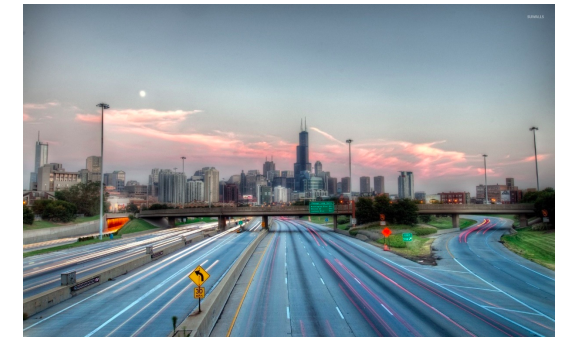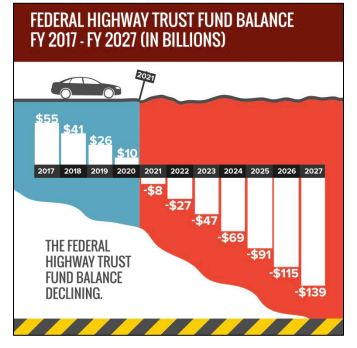TRIP
 Transportation and Economic Development
Transportation and Economic Development
The health and future growth of Illinois’ economy is riding on its transportation system. Each year, $2.9 trillion in goods are shipped to, from and within Illinois, mostly by truck. Projected increases in passenger and freight movement will place further burdens on the state’s already deteriorated and congested network of roads and bridges. By 2045, total freight tonnage being shipped in, out and within Illinois is projected to grow by 40 percent, with 70 percent of the added tonnage moved by truck.
The design, construction and maintenance of transportation infrastructure in Illinois supports 154,001 full-time jobs across all sectors of the state economy. These workers earn $6.5 billion annually. Approximately 2.6 million full-time jobs in Illinois in key industries like tourism, manufacturing, retail sales, agriculture are completely dependent on the state’s transportation infrastructure network.
Each dollar spent on road, highway and bridge improvements results in an average benefit of $5.20 in the form of reduced vehicle maintenance costs, reduced delays, reduced fuel consumption, improved safety, reduced road and bridge maintenance costs and reduced emissions as a result of improved traffic flow.
Introduction
Illinois’ roads, highways and bridges form vital transportation links for the state’s residents, visitors and businesses, providing daily access to homes, jobs, shopping, natural resources and recreation. Modernizing Illinois’ transportation system is critical to quality of life and economic competitiveness in the Prairie State. Inadequate transportation investment, which will result in deteriorated transportation facilities and diminished access, will negatively affect economic competitiveness and quality of life in Illinois.
To accommodate population and economic growth, maintain its level of economic competitiveness and achieve further economic growth, Illinois will need to maintain and modernize its roads, highways and bridges by improving the physical condition of its transportation network and enhancing the system’s ability to provide efficient, reliable and safe mobility for residents, visitors and businesses. Making needed improvements to Illinois’ roads, highways, bridges and transit systems could also provide a significant boost to the state’s economy by creating jobs in the short term and stimulating long-term economic growth as a result of enhanced mobility and access.
This report examines the condition, use and safety of Illinois’ roads, highways and bridges and the future mobility needs of the state. Sources of information for this report include the Illinois Department of Transportation (IDOT), the Federal Highway Administration (FHWA), the American Association of State Highway and Transportation Officials (AASHTO), the Bureau of Transportation Statistics (BTS), the U.S. Census Bureau, the Texas Transportation Institute (TTI), the National Highway Traffic Safety Administration (NHTSA), and the American Road and Transportation Builders Association (ARTBA).
Population, Travel and Economic Trends in Illinois
Illinois motorists and businesses require a high level of personal and commercial mobility. To foster quality of life and spur continued economic growth, it will be critical that the state provide a safe and modern transportation system that can accommodate future growth in population, tourism, business, recreation and vehicle travel.
Illinois’ population grew to approximately 12.8 million residents in 2016, a three percent increase since 2000.1 Illinois had approximately 9.1 million licensed drivers in 2016. 2 From 2000 to 4 2016, Illinois’ gross domestic product (GDP), a measure of the state’s economic output, increased by 14 percent, when adjusted for inflation.3 U.S. GDP increased 30 percent during this period.4
From 2000 to 2016, annual VMT in Illinois increased by four percent, from 102.9 billion miles traveled annually to 107.3 billion miles traveled annually.5 Vehicle travel in Illinois increased two percent in the last three years (2013-2016).6
Condition of Illinois Roads
The life cycle of Illinois’ roads is greatly affected by the state and local governments’ ability to perform timely maintenance and upgrades to ensure that road and highway surfaces last as long as possible.
The pavement data in this report, which is for all arterial and collector roads and highways, is provided by the Federal Highway Administration (FHWA), based on data submitted annually by the Illinois Department of Transportation on the condition of major state and locally maintained roads and highways. Pavement data for Interstate highways and other principal arterials is collected for all system mileage, whereas pavement data for minor arterial and all collector roads and highways is based on sampling portions of roadways as prescribed by FHWA to insure that the data collected is adequate to provide an accurate assessment of pavement conditions on these roads and highways.
Statewide, nearly one-third of Illinois’ major roads are in poor or mediocre condition. Seventeen percent of Illinois’ major locally and state-maintained roads are in poor condition and 14 percent are in mediocre condition.7 Thirteen percent are in fair condition and the remaining 56 percent are in good condition.8
Twenty-seven percent of Illinois’ major locally and state-maintained urban roads and highways have pavements rated in poor condition and nine percent are in mediocre condition.9 Ten percent of Illinois’ major urban roads are rated in fair condition and the remaining 54 percent are rated in good condition.10
Three percent of Illinois’ major locally and state-maintained rural roads and highways have pavements rated in poor condition and 19 percent are in mediocre condition.11 Eighteen percent of Illinois’ major rural roads are rated in fair condition and the remaining 60 percent are rated in good condition.12
The condition of state-maintained roads and highways in Illinois is expected to deteriorate further, based on current levels of state funding. A 2017 IDOT report found that the share of statemaintained roads and highways that have deteriorated to the point where an improvement is needed now is anticipated to increase from 23 percent in 2018 to 35 percent in 2023 (from 3,596 miles to 5,588 miles of the 15,968 miles). 13
The chart below details pavement conditions on major urban roads in the state’s largest urban areas. 14
 Pavement failure is caused by a combination of traffic, moisture and climate. Moisture often works its way into road surfaces and the materials that form the road’s foundation. Road surfaces at intersections are even more prone to deterioration because the slow-moving or standing loads occurring at these sites subject the pavement to higher levels of stress. It is critical that roads are fixed before they require major repairs because reconstructing roads costs approximately four times more than resurfacing them.15 As roads and highways continue to age, they will reach a point of deterioration where routine paving and maintenance will not be adequate to keep pavement surfaces in good condition and costly reconstruction of the roadway and its underlying surfaces will become necessary.
Pavement failure is caused by a combination of traffic, moisture and climate. Moisture often works its way into road surfaces and the materials that form the road’s foundation. Road surfaces at intersections are even more prone to deterioration because the slow-moving or standing loads occurring at these sites subject the pavement to higher levels of stress. It is critical that roads are fixed before they require major repairs because reconstructing roads costs approximately four times more than resurfacing them.15 As roads and highways continue to age, they will reach a point of deterioration where routine paving and maintenance will not be adequate to keep pavement surfaces in good condition and costly reconstruction of the roadway and its underlying surfaces will become necessary.
Long-term repair costs increase significantly when road and bridge maintenance is deferred, as road and bridge deterioration accelerates later in the service life of a transportation facility and requires more costly repairs. A report on maintaining pavements found that every $1 of deferred maintenance on roads and bridges costs an additional $4 to $5 in needed future repairs.16
…
Transportation Funding
 Investment in Illinois’ roads, highways and bridges is funded by local, state and federal governments. A lack of sufficient funding at all levels will make it difficult to adequately maintain and improve the state’s existing transportation system.
Investment in Illinois’ roads, highways and bridges is funded by local, state and federal governments. A lack of sufficient funding at all levels will make it difficult to adequately maintain and improve the state’s existing transportation system.
The federal government is a critical source of funding for Illinois’ roads, highways, bridges and transit systems and provides a significant return in road and bridge funding based on the revenue generated in the state by the federal motor fuel tax.
Most federal funds for highway and transit improvements in Illinois are provided by federal highway user fees, largely an 18.4 cents per-gallon tax on gasoline and a 24.4 cents-per gallon tax on diesel fuel. Since 2008 revenue into the federal Highway Trust Fund has been inadequate to support legislatively set funding levels so Congress has transferred approximately $53 billion in general funds and an additional $2 billion from a related trust fund into the federal Highway Trust Fund.37
Download full version (PDF): Illinois Transportation by the Numbers
About TRIP
www.tripnet.org
Founded in 1971, TRIP ® of Washington, DC, is a nonprofit organization that researches, evaluates and distributes economic and technical data on surface transportation issues. TRIP is sponsored by insurance companies, equipment manufacturers, distributors and suppliers; businesses involved in highway and transit engineering and construction; labor unions; and organizations concerned with efficient and safe surface transportation.






 RSS Feed
RSS Feed